|
MONUMENTS at
|
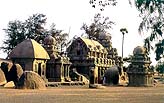
King Mamalla and his successors of the Pallava Dynasty have left to us numerous temples and rock sculptures along the coast of Mahabalipuram, which was historically referred to as Mamallapuram, a port town facing Bengal Bay. This is a very important historic cultural site as one of the cradle lands of medieval architecture in India, embracing cave temples in rock hills, rock sculptures, rock carved temples, and early stone temples. Among them, a series of unique rock carved temples called ‘Five Rathas,’ which were unearthed in the 19th century, is worth notice in their variety of architectural forms along with their wall carvings. |
|
Currently a tiny village, Mahabalipuram was the most important port town on the Coromandel coastline in the 7th century. There, even in the evening, the sounds of masons’ hammers and chisels never stopped. For several decades they carved rocks at an exposed elongated rock hill lying about 400m from the coast. They sculpted out in relief the splendid scenes of ancient legends on a hard granite rock. On the rock hill, more than ten cave temples were excavated, on the frontage of which lion columns stand. Each cave temple has a Garbhagriha (sanctuary) and a Mandapa (worship hall), on the walls of which are sculpted relief panels, which are the best representative of the art of the Pallava Dynasty. Almost simultaneously with those cave temples, they carved out substantial rock temples from exposed independent rocks. Though those carved temples are on a relatively small-scale, they show the primary shape of Indian medieval architecture with its tropical placid formation However, unfinished carved rock temples and cave temples are not few. When looking at such abandoned caves and rough-hewn rock carvings, one might be able to hear the raw voices of these ancient masons and sculptors.

The reasons for their incompleteness are blurred, but one of them might have been the progress of construction techniques. That is to say, the 8th century saw the start of a construction system of stone temples by piling ashlars conveyed from faraway quarries, precisely cut on the basis of a strictly designed scheme, instead of carving a temple from a rock on the spot.
The first practice of that method in south India is the 'Shore Temple’ on the seashore of Mahabalipuram. Later, the hub of construction activity in the Pallava Dynasty (c. 300-c. 910) was switched to its capital Kanchipuram, where numerous stone temples would be built.
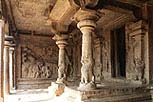
Though the origin of the Pallava Dynasty, which left as many as 60 stone temples in southeastern India, such as in Mahabalipuram, is not clear, it seems to have come down from the north and established the state as early as in the 4th century. It spread its power in the southeastern part of the Indian peninsula, the current state of Tamil Nadu, from the late 6th century to the 7th century, contending for supremacy with the Chalukya Dynasty based on Badami and the Pandya Dynasty in the extreme south of India. The Pallava Dynasty opened this port town, Mahabalipuram, around the 6th century as the base for its coastal trade, although its capital was Kanchipuram, 65km west. Its heyday was the ruling age of Narasimhavarman I (r. c. 630-668), who was given an honorific title ‘mamalla’ or ’maha-malla’ (great warrior), from which the town was designated as Mamallapuram. From here, Tamil merchants launched out into Sri Lanka and even to Southeast Asia. As the Pallavas were Hindus, the ancient remnants are all Hindu temples and sculptures. It was mainly from the age of Narasimhavarman I that the cave temples were excavated on the rock hill, soaring at the rear of the town. Their columns were thick and square at the outset, but gradually became more slender and lions, symbol of the Pallava Dynasty, were carved on their lower parts. The lions would be sculpted in a standing posture on columns in later ages, but here they still take a squatting pose.

The largest cave is the Pancha Pandava Mandapa Cave, on the façade of which two rows of six lion columns and tail end pilasters without lions. The central shrine is unfinished and there are no carvings on the walls of the Mandapa (worship hall). The Varaha Mandapa Cave with four rows of delicate lion columns on its facade is an elaborately carved cave, though small, with sculptures in relief covering the entire walls of the Mandapa. The cave was dedicated to Vishnu, who is depicted in relief on the left wall, sustaining the ground from the seabed in the incarnation of Varaha (boar). On the rear wall is depicted in relief a scene of an elephant spraying water on the consort of Vishnu and the goddess of fortune, Lakshmi. At the Mahishamardini Mandapa Cave is depicted a scene of Goddess Durga, Shiva’s consort, with eight arms on a lion’s back, eliminating the demon Mahisha in the figure of a buffalo.
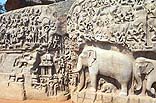
The most famous sculpture in relief in Mahabalipuram is the colossal carving on a rock with a central long crack, more than 10m high and 32m long. Its sculpture of a group of living creatures has long been exposed to the elements, and its theme has been forgotten and is now interpreted in two ways. One interpretation is to see it as the episode of ‘Arjuna’s Penance’ from the “Mahabharaha.” A prince of the Kuru tribe, Arjuna is practicing penance in order to gain Shiva’s divine protection, standing on one leg at the center of the composition, surrounded by mythical gods and animals. Another interpretation suggests it is the ‘Ganga’s Descent’ of Hindu mythology. Applying the central crack of the rock to Ganga (Ganges) falling from the heavens to the earth, it depictsasn ascetic Baghiratha moving Shiva’s heart to let river water fall. The serpent deities Naga and Nagi stand in the falling water and on the left is carved a southern style temple. An elephant family on the right side carved quite realistically can be considered a masterpiece of Pallava sculpture.
The sculptors vividly depicted a fantastic world, in which gods and humans are mingled, on a reddish granite rock. Though the expressions of human bodies are slim and stiff in contrast to the plumpness of expressions in northern India, their total compositions and depictions are alive and vibrant. The narrative sculptures like this sailed across the sea and strongly influenced to the Hindu art in faraway Java in Indonesia and Cambodia.

There is a series of freestanding rock temples carved from scattered granite rocks (from one continuous underground rock) in a sandy place some hundreds meters south from the village of Mahabalipuram. It gives the impression of an idyllic fairyland and is called the ‘Pancha Ratha’ (Five Rathas). A ratha means a cart or carriage, hence a temple or a festival car as a vehicle for a god came also to be called a ratha.

Each Ratha is designated as one of the characters in the “Mahabharata” and has a variety in architectural style: the northernmost Draupati Ratha is carved in a pyramidal roof type, the Nakula Sahadeva Ratha is in a horseshoe chyaitya type, the Arjuna Ratha and Darmaraja Ratha are in the Vimana type of the southern style, and Bhima Ratha is in a Gopura type with a gabled roof. Every Ratha has columns and pilasters on the ground floor. Gods or kings are carved in niches framed with the pilasters. Except the Draupati Ratha, the upper part of each Ratha takes a stepped pyramidal shape in the southern style. Each horizontal step consists of miniature shrines and chaitya windows. The southern style Vimanas are surmounted with hemispherical crowning stones, called ‘Shikhara’ in south India. The Garubhagriha (sanctuary) of every Ratha is simple and narrow. The Darmarajika Ratha was abandoned before the sanctuary was excavated.
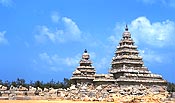
It was in the age of Narasimhavarman II (r. 700-728), who was also called Rajasimha, that a temple was erected by piling cut stones on the seashore of Mahabalipuram. This is considered the first stone temple in India, in the transitional period from ancient cave temples to mediaeval stone buildings.
This ‘Shore Temple’ consists of two towering Vimanas, one large and one smaller, in the southern style leaning towards each other, both of which are surmounted with hemispherical crowning stones. Each tower is in the southern style with piled horizontal steps, but their silhouettes rise more steeply, as in the northern style. Although this temple was dedicated to Shiva, there is one more shrine without a tower between the two Vimanas, where a ‘lying Vishnu’ in relief is seen on its floor. It was probably carved on the rock insitu in the 7th century and the Shiva temple was constructed on the spot in the 8th century. Vishnu as a protector of the world faces the land and Shiva, in charge of destruction, was set in the east side, looking out at the stormy sea.
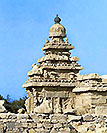
The Pallava Dynasty that had developed early stone Hindu temples fell into ruin early in the 10th century. The port town Mahabalipuram also decayed rapidly and the temples, which had a great deal of influence over the temple architecture of south India, could not be spared destruction. Some of the temples were washed away by waves of the Bay of Bengal and likely disappeared with the retreat of the coastline (In "UNESCO World Heritage" vol. 5. 1997, Kodan-sha ) |
E-mail to: kamiya@t.email.ne.jp